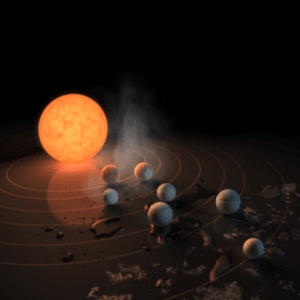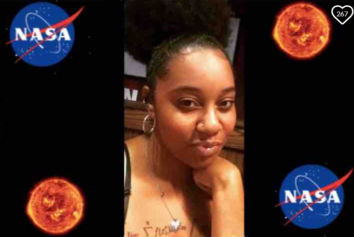
Three planets in the Trappist-1 system were previously discovered in May 2016. Illustration by NASA/JPL-Caltech.
To infinity and beyond? It turns out astronomers didn’t have to go quite that far to discover seven earth-size planets that could potentially harbor life orbiting a dwarf star some 40 light-years away from Earth.
The planets, orbiting an “ultracool dwarf” star dubbed Trappist-1, are located nearly 235 trillion miles from our own planet, which is relatively close in cosmic terms, according to astronomers. The orbit patterns of the newly discovered planets allow for detailed studying, and astronomers say one or more of the bodies could potentially be flush with oceans, considering their distance from the dwarf star.
“The seven wonders of TRAPPIST-1 are the first Earth-size planets that have been found orbiting this kind of star,” said Michael Gillon, an astronomer at the University of Liege in Belgium who leads the international team that’s been studying the Trappist-1 system.
Thomas Zurbuchen, associate administrator of NASA’s Science Mission Directorate in Washington, expressed excitement at the possibility of discovering alien life on the new planets.
“This discovery could be a significant piece in the puzzle of finding habitable environments, places that are conducive to life,” Zurbuchen said at a NASA press conference on Wednesday, Feb. 22. “Answering the question, ‘Are we alone?’ is a top science priority and finding so many planets like these for the first time in the habitable zone is a remarkable step forward toward that goal.”
NASA’s Spitzer Space Telescope made the new discoveries this week, as its latest findings were published Feb. 22 in the journal Nature. The agency’s website states that three of the planets are located in the “habitable zone,” which describes the area around the star where rocky planets are more likely to have liquid water. Researchers say all seven of the planets could have liquid water, but only if the atmospheric conditions are right.
Named after the Transiting Planets and Planetesimals Small Telescope (TRAPPIST) in Chile, three of the planets in the Trappist-1 system were initially discovered in May 2016. With the help of numerous ground-based telescopes, including the European Southern Observatory’s Very Large Telescope, Spitzer was able to confirm the existence of two of these planets and discovered five additional ones in the process, according to a NASA press release.
A team of astronomers then used data from the Spitzer Space Telescope to measure the sizes of the seven planets and develop estimates for the masses of six of them. The majority of the exoplanets are likely to be rocky, but astronomers believe the seventh and furthest planet may be an “icy, snowball-like” mass.
“This is the most exciting result I have seen in the 14 years of Spitzer operations,” said Sean Carey, manager of NASA’s Spitzer Science Center at Caltech/IPAC in Pasadena, Calif. “Spitzer will follow up in the fall to further refine our understanding of these planets so that the James Webb Space Telescope can follow up. More observations of the system are sure to reveal more secrets.”
While the Trappist-1 planets are roughly the size of Earth, their parent star is much different from our own. For one, the “ultracool dwarf” is one-twelfth the size of the sun and has a surface temperature of just 4,150 degrees Fahrenheit, The New York Times reported. This pales in comparison to our sun’s 10,000 degrees.
To provide an even clearer visual, Gillion used this analogy: If the sun was a basketball, then the Trappist-1 star would be a golf ball. However, like our moon, astronomers believe the three closest planets may be tidally locked. This means that the planets always present one side to the star; it is perpetually daytime on one side of the planet, always night on the other.
In the wake of their amazing discovery, NASA has since released a series of illustrated posters depicting what life would be like on the seven planets.
“Some 40 light-years from Earth, a planet called TRAPPIST-1e offers a heart-stopping view: brilliant objects in a red sky, looming like larger and smaller versions of our own moon. But these are no moons,” NASA’s description of the “new world’ reads. “They are other Earth-sized planets in a spectacular planetary system outside our own. These seven rocky worlds huddle around their small, dim, red star, like a family around a campfire.


